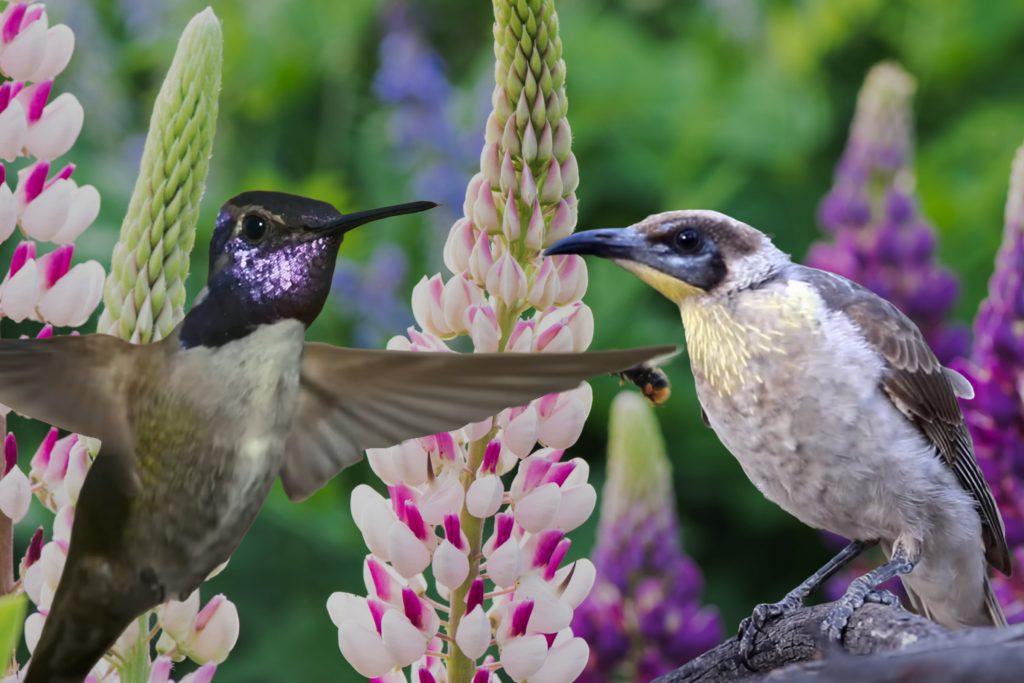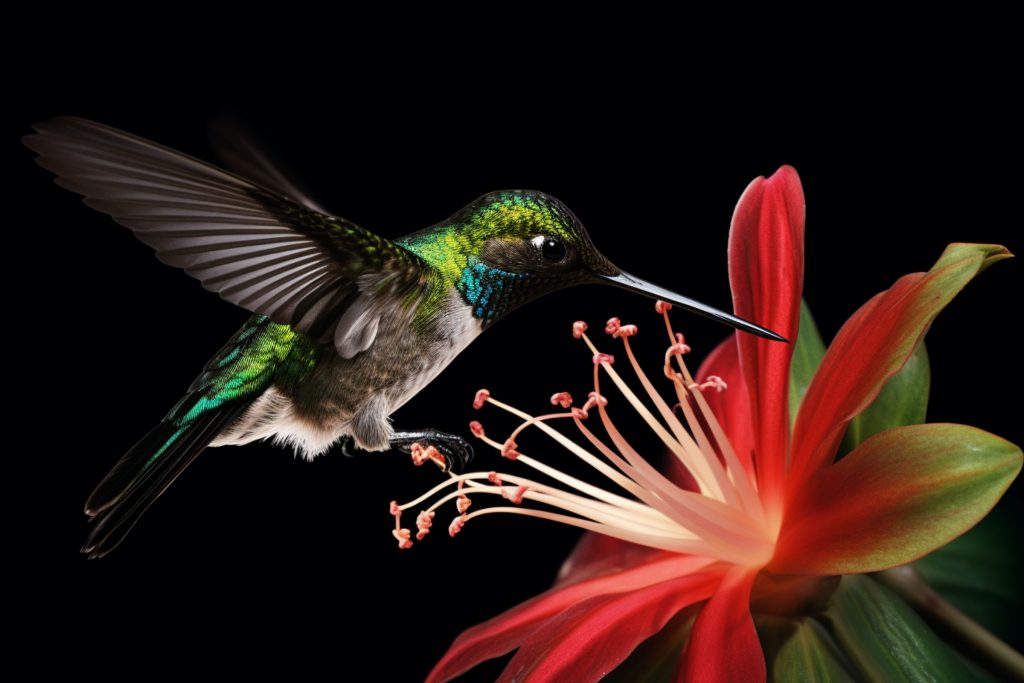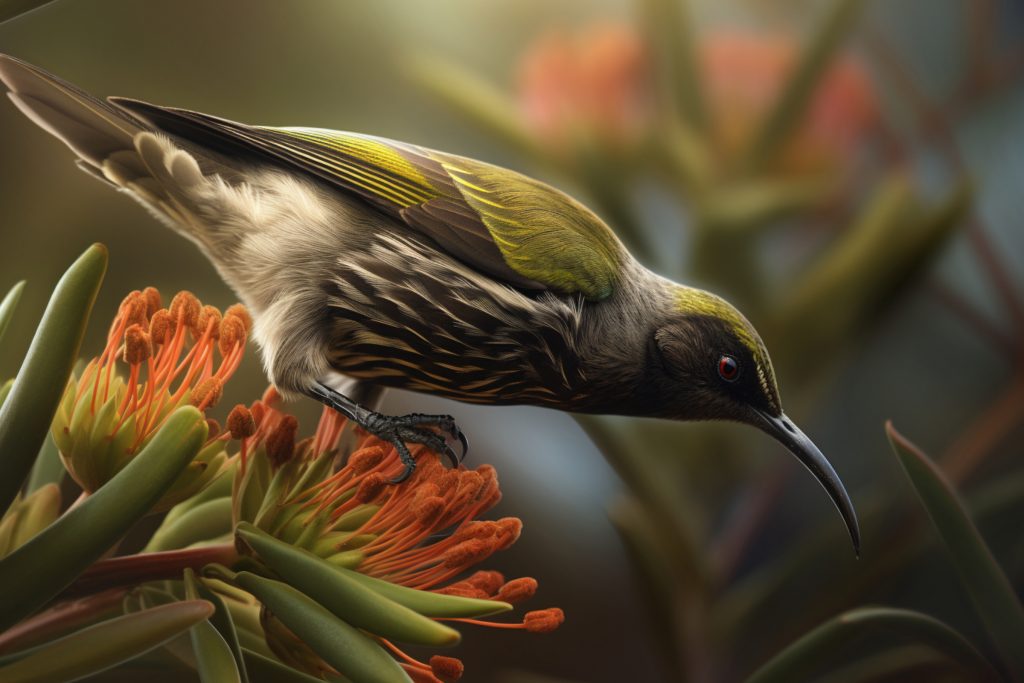No, there are no hummingbirds in Australia. Hummingbirds are native to the Americas and are not found in the wild in Australia. However, Australia has its own nectar-feeding birds, like the honeyeaters.
These birds fill a similar ecological role to hummingbirds but are not related to them. So, while you won’t see hummingbirds, you will see other colourful, nectar-loving birds in Australia.

The Difference between Hummingbirds and Honeyeaters
Hummingbirds and honeyeaters are two distinct bird families that share some similarities, such as their nectar-feeding habits and roles in pollination. However, they also exhibit notable differences in appearance, behaviour, and geographical distribution.
Let’s explore these differences in detail:
Naming and location:
There are over 300 species of hummingbirds (approximately about 366 species), all belonging to the family Trochilidae. Actual hummingbirds are native to the Americas, spanning North, Central, and South America, from Alaska to Tierra del Fuego. Some well-known American hummingbirds include the Ruby-throated Hummingbirds, Rufous Hummingbirds, and Blue-throated Hummingbirds. Hummingbirds are not found anywhere else in the world.
Honeyeaters, on the other hand, belong to the family Meliphagidae and are native to Australia, New Guinea, and surrounding islands. They are not found in the Americas.
Size and appearance:
Hummingbirds are generally small, with most species measuring 3-5 inches in body length. Their body weight is usually quite low, ranging from 2 to 20 grams. Hummingbirds are known for their iridescent plumage, which often displays vibrant colours, such as green hummingbirds and other striking hues.
Honeyeaters come in a wider range of sizes, from small birds like the Eastern Spinebill (around 5.5 inches) to larger ones like the Noisy Friarbird (up to 13 inches). Their plumage is often less vibrant than that of hummingbirds, although some species do have bright colours.

Flight and feeding behaviour:
Hummingbirds have unique hovering abilities, which allow them to feed on nectar from flowers, including hummingbird-shaped flowers, while suspended in mid-air. They achieve this through rapid wingbeats, which can reach up to 80 beats per second. Their diet primarily consists of nectar, but they also consume insects and spiders for protein.
Honeyeaters, while also feeding on nectar, do not possess the same hovering ability as hummingbirds. Instead, they generally perch on branches or use their feet to cling to flowers while feeding. Some species of honeyeaters also feed on insects and fruit.
Bill, tongue structure, and hummingbird song production:
Hummingbirds have long, slender bills adapted for sipping nectar from tubular flowers. Their tongue is forked and functions like a micro pump, allowing them to efficiently extract nectar. Hummingbirds also have a unique vocal organ called the syrinx, which enables them to produce complex songs and calls.
Honeyeaters have bills that vary in size and shape, depending on their feeding habits. Some species have curved, slender bills for extracting nectar, while others have sturdier bills for catching insects or manipulating fruit. Honeyeaters also have a brush-tipped tongue with bristles that help them collect nectar.

Reproduction and nesting:
Hummingbirds typically build small, cup-shaped nests using plant fibres, spider silk, and other materials. The female lays two eggs and is solely responsible for incubating them and raising the chicks.
Honeyeater nesting habits vary by species, but many construct cup-shaped or domed nests using plant fibres, bark, and sometimes mud. The number of eggs laid can range from one to four, and both parents usually participate in incubation and chick-rearing.
Related species: Hummingbird moths and Hummingbird Hawkmoths:
It’s worth noting that hummingbird moths and Hummingbird Hawkmoths are not birds but rather insects. These moths resemble hummingbirds in their hovering flight and feeding behaviour, as they feed on nectar from flowers using their long proboscis. However, they are not related to hummingbirds or honeyeaters.
While hummingbirds and honeyeaters share some similarities in nectar-feeding habits and pollination roles, they are distinct families of birds with different appearances, behaviours, and geographic distributions.
Geography of Australia
Australia is a vast continent with diverse climates, vegetation, and wildlife. From tropical rainforests in the north to the arid deserts in the interior, the country boasts a wide range of habitats that support various plant and animal species. Wildflowers, in particular, are abundant in Australia, providing a rich source of nectar for pollinators.
One might think that such a diverse landscape would be ideal for hummingbirds. However, their absence in Australia is tied to more than just environmental factors.
Native Bird Species in Australia
Australia is home to an incredible array of unique bird species, many of which are found nowhere else in the world. From the iconic kookaburra to the colourful lorikeet, the continent’s bird population is truly remarkable. Despite this diversity, hummingbirds are not among Australia’s native bird species.
The absence of hummingbirds in Australia is due to their geographic origin, with all known species native to the Americas. Consequently, hummingbirds have never been part of the Australian ecosystem.
Introduced Species in Australia
Over the years, various animal species have been introduced to Australia, either intentionally or unintentionally. Some, like the European rabbit and cane toad, have had significant negative impacts on the environment and native wildlife.
Despite the potential for introduced species to adapt to new environments, there is no evidence of hummingbirds having been introduced to Australia. Given their specific dietary and habitat requirements, it is unlikely that they would thrive in the Australian environment even if introduced.

Similar Species to Hummingbirds
Australia is home to bird species that share some similarities with hummingbirds, such as their appearance and nectar-feeding behaviour. One such example is the honeyeater, which belongs to the Meliphagidae family. Honeyeaters play an essential role in pollination and can be found throughout Australia.
The presence of honeyeaters in Australia, while hummingbirds are absent, can be attributed to their different evolutionary paths and geographic origins.
Conclusion
In conclusion, there are no hummingbirds in Australia, either as native or introduced species. The unique bird species found in Australia, such as honeyeaters, have evolved separately from hummingbirds and have adapted to the diverse Australian environment.
Understanding the presence or absence of specific species in a region can help us appreciate the intricate web of life and the delicate balance of ecosystems. By learning more about the unique wildlife in Australia and around the world, we can better appreciate the planet’s incredible biodiversity and work towards its preservation.

FAQs – Are there Hummingbirds in Australia?
Q: Are there hummingbirds in Australia?
A: No, hummingbirds are not found in Australia. They are native to the Americas, spanning North, Central, and South America.
Q: What is the main food source for hummingbirds?
A: Hummingbirds primarily feed on nectar from flowers, but they also consume insects and spiders for protein.
Q: How many species of hummingbirds are there?
A: There are over 300 species of hummingbirds, all belonging to the family Trochilidae.
Q: What are some well-known American hummingbirds?
A: Some well-known American hummingbirds include Ruby-throated Hummingbirds, Rufous Hummingbirds, and Blue-throated Hummingbirds.
Q: How do hummingbirds feed on nectar from flowers?
A: Hummingbirds use their long, slender bills and forked tongues to sip nectar from tubular flowers, often while hovering in mid-air.
Q: What is the typical body length and weight of hummingbirds?
A: Hummingbirds generally measure 3-5 inches in body length and weigh between 2 to 20 grams.
Q: What are hummingbird moths and Hummingbird Hawkmoths?
A: Hummingbird moths and Hummingbird Hawkmoths are not birds but rather insects that resemble hummingbirds in their hovering flight and nectar-feeding behaviour.
Q: How do hummingbirds produce their songs and calls?
A: Hummingbirds have a unique vocal organ called the syrinx, which enables them to produce complex songs and calls.
Q: Are there bird species in Australia that resemble hummingbirds?
A: Yes, honeyeaters are native to Australia and share some similarities with hummingbirds, such as nectar-feeding habits and roles in pollination.
Q: What is the largest species of a hummingbird?
A: The Giant Hummingbird is the largest species of hummingbird.
Q: Do hummingbirds have a specific type of flower they prefer?
A: Hummingbirds are often attracted to hummingbird-shaped flowers and tubular flowers that provide nectar.
Q: What is the hovering ability of a hummingbird?
A: Hummingbirds can hover in mid-air by rapidly flapping their wings up to 80 beats per second, allowing them to feed on nectar from flowers while suspended in place.
Q: Are there any hummingbird species found outside of the Americas?
A: No, hummingbirds are exclusively found in the Americas, including North, Central, and South America.
Q: What role do hummingbirds play in the ecosystem?
A: Hummingbirds play a crucial role in pollination, as they transfer pollen from flower to flower while feeding on nectar.
Q: Can hummingbirds see colour?
A: Yes, hummingbirds have excellent colour vision, which helps them locate brightly coloured flowers rich in nectar.
Q: Are there diurnal species of hummingbirds?
A: Yes, most hummingbirds are diurnal species, meaning they are active during the day.
Q: How do honeyeaters feed on nectar?
A: Honeyeaters use their bills and brush-tipped tongues to extract nectar from flowers while perching or clinging to the flowers.
Q: What is the main difference between hummingbirds and honeyeaters?
A: The main difference between hummingbirds and honeyeaters is their geographic distribution, with hummingbirds native to the Americas and honeyeaters native to Australia and surrounding regions.
Q: Do hummingbirds migrate?
A: Yes, many species of hummingbirds, such as the Ruby-throated Hummingbird, undertake long migrations between their breeding and wintering grounds.
Q: Are there any flowers specifically adapted for hummingbird pollination?
A: Yes, some flowers, such as hummingbird-pollinated flowers and tubular flowers, are specifically adapted for hummingbird pollination. These flowers are often brightly coloured, rich in nectar, and have a shape that accommodates the hovering and feeding behaviour of hummingbirds.
Q: What is the primary hummingbird food?
A: The primary food source for hummingbirds is nectar from flowers, supplemented by insects and spiders for protein.
Q: Do hummingbirds exist in North America, Central America, and South America?
A: Yes, hummingbirds are native to the Americas, including North, Central, and South America.
Q: What is the Hummingbird Hawkmoth?
A: The Hummingbird Hawkmoth is an insect that resembles a hummingbird in appearance and behaviour, known for its hovering flight and nectar-feeding habits.
Q: Can hummingbirds be found in Western Australia?
A: No, hummingbirds are not native to Australia, including Western Australia. They are exclusively found in the Americas.
Q: What is the average wingbeat frequency for a hummingbird?
A: A hummingbird’s wingbeat frequency can reach up to 80 beats per second, allowing them to hover in mid-air with remarkable flight stability.
Q: Can I use food dye in homemade hummingbird nectar?
A: It is not recommended to use food dye in homemade hummingbird nectar, as it can be harmful to the birds. A common recipe for hummingbird nectar is to mix 1 part sugar with 4 parts water, with no added colouring.
Q: What are some plants that attract hummingbirds?
A: Hummingbird plants include brightly coloured, tubular flowers that produce nectar, such as trumpet vine, bee balm, and salvia.
Q: When do hummingbirds migrate in North America?
A: In North America, hummingbird migration typically occurs during late summer and early fall, with the exact timing depending on the species and location.
Q: How do hummingbirds maintain their body temperature?
A: Hummingbirds can regulate their body temperature through various methods, including fluffing their feathers for insulation, shivering to generate heat, and entering torpor (a state of reduced metabolic activity) during cold nights.
Q: What role do flower colours play in attracting hummingbirds?
A: Flower colours play an essential role in attracting hummingbirds, as their bright colours and excellent colour vision help them locate flowers rich in nectar.
Q: How do hummingbird eyes contribute to their ability to find nectar-rich flowers?
A: Hummingbird eyes have excellent colour vision, allowing them to spot brightly coloured flowers that are often rich in nectar and navigate their environment efficiently.
Q: What is a broad-tailed hummingbird?
A: The broad-tailed hummingbird is a medium-sized hummingbird species native to North America, known for its metallic trill produced by the male’s wings during flight.
Q: How can I help an injured hummingbird?
A: If you find an injured hummingbird, it is best to contact a local hummingbird rehabilitator or wildlife rescue organization for advice and assistance in providing the appropriate care for the bird.
Q: What is the significance of hummingbird talismans in some cultures?
A: In some cultures, hummingbird talismans symbolize love, happiness, and energy due to the bird’s vibrant colours, rapid flight, and association with the life-sustaining nectar of flowers.
A: Hummingbirds use a combination of factors for navigation during migration, including the position of the sun, stars, and Earth’s magnetic field, as well as their innate sense of direction and memory of previous migratory routes.
Q: Are there any special adaptations in the interface of hummingbird flight and feeding?
A: Yes, hummingbirds have unique adaptations for flight and feeding, including their rapid wingbeats for hovering, long slender bills for reaching nectar in tubular flowers, and specialized forked tongues for efficient nectar extraction.
Q: How do hummingbirds affect the pollination of flowers?
A: As hummingbirds feed on nectar, they inadvertently transfer pollen between flowers on their bills and head, facilitating cross-pollination and contributing to the reproduction and genetic diversity of flowering plants.
Related Posts to Read:
- Are There Hummingbirds In Africa?
- Are There Hummingbirds in Europe?
- Are There Hummingbirds In Alaska?
- Are There Hummingbirds In Florida?
- Are There Hummingbirds In Massachusetts?
- Are There Hummingbirds In Michigan?
- Are There Hummingbirds In Texas?
- Are There Hummingbirds In New Jersey?
- Are There Hummingbirds In New York?
- Are There Hummingbirds In Mexico?
References:
- About Hummingbird (Wikipedia).
- Greenewalt, C. H. (1960). Hummingbirds. New York: Doubleday (Google Scholar).
- About Australia (Wikipedia).
